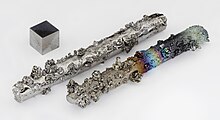Frae Wikipedia, the free beuk o knawledge
Tungsten, 74 Tungsten Pronunciation (TUNG -stən Appearance riach, lustrous Standard atomic weight A r, std (W) 7002183840000000000♠ 183.84(1)[1] Tungsten in the periodic cairt
Atomic nummer (Z ) 74 Group group 6 Period period 6 Block d-block Element category Transeetion metal Electron confeeguration [Xe ] 4f14 5d4 6s2 [2] Electrons per shell 2, 8, 18, 32, 12, 2 Pheesical properties Phase at STP solit Meltin pynt 3695 K (3422 °C, 6192 °F) Bylin pynt 5828 K (5555 °C, 10031 °F) Density (near r.t. ) 19.25 g/cm3 when liquid (at m.p. ) 17.6 g/cm3 Creetical pynt 13892 K, MPa Heat o fusion 35.3 kJ/mol Heat o vapourisation 806.7 kJ/mol Molar heat capacity 24.27 J/(mol·K) Vapour pressur
P (Pa)
1
10
100
1 k
10 k
100 k
at T (K)
3477
3773
4137
4579
5127
5823
Atomic properties Oxidation states −4, −2, −1, 0, +1, +2, +3, +4 +6 acidic oxide) Electronegativity Pauling scale: 2.36 Atomic radius empirical: 139 pm Covalent radius 162±7 pm Colour lines in a spectral range Spectral lines o tungstenIther properties Naitural occurrence primordial Creestal structur body-centred cubic (bcc) Speed o soond thin rod (annealed) 4620 m/s (at r.t. ) Thermal expansion 4.5 µm/(m·K) (at 25 °C) Thermal conductivity 173 W/(m·K) Electrical resistivity 52.8 n Ω·m (at 20 °C) Magnetic orderin paramagnetic [3] Young's modulus 411 GPa Shear modulus 161 GPa Bulk modulus 310 GPa Poisson ratio 0.28 Mohs haurdness 7.5 Vickers haurdness 3430 MPa Brinell haurdness 2570 MPa CAS Nummer 7440-33-7 History Diskivery Torbern Bergman (1781) First isolation Juan José Elhuyar an Fausto Elhuyar (1783) Main isotopes o tungsten
Decay modes in parentheses are predictit, but hae nae yet been observed references
Tungsten , kent as wolfram an aa, is a chemical element wi the chemical seembol W an atomic nummer 74. The wird tungsten comes frae the Swadish leid tung sten directly translatable tae hivy stane ,[5] volfram in Swadish fur tae distinguish it frae Scheelite , at in Swadish is alternatively named tungsten .



